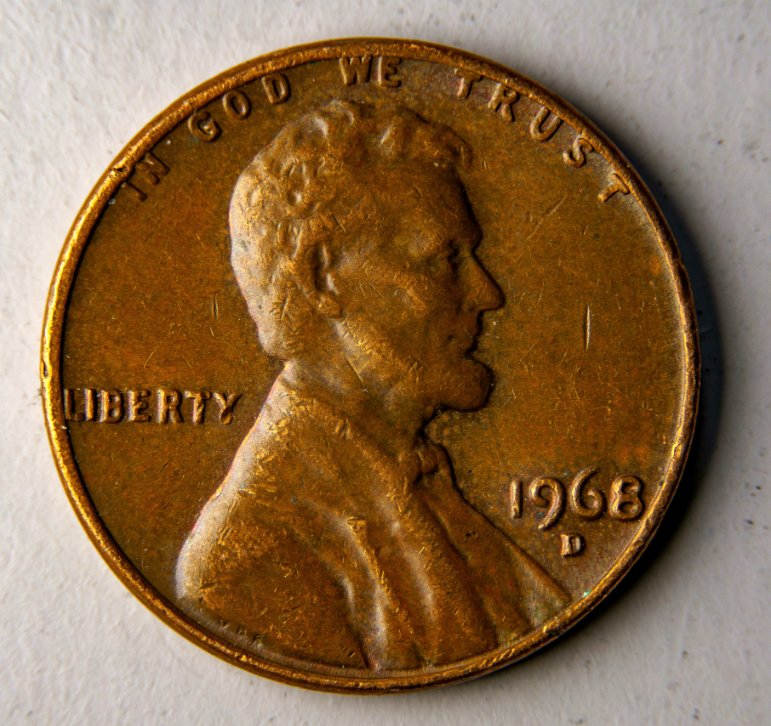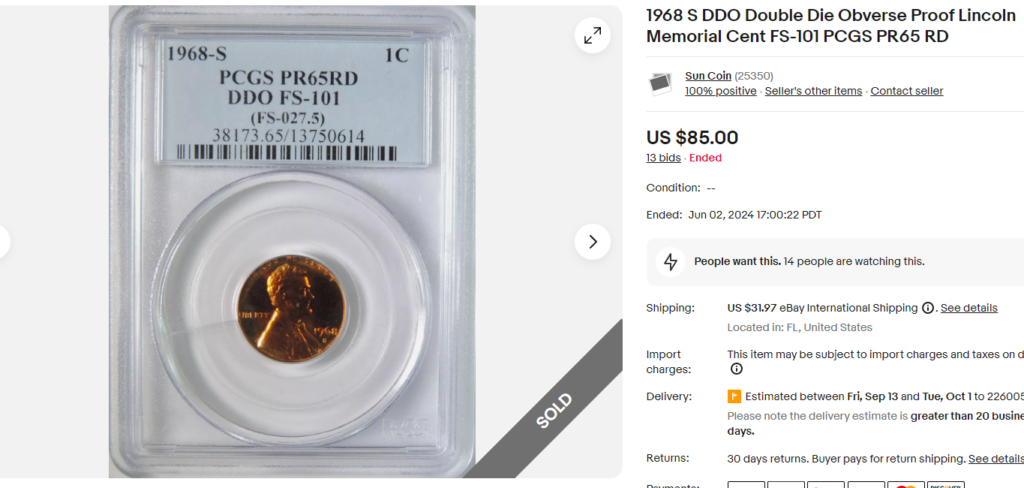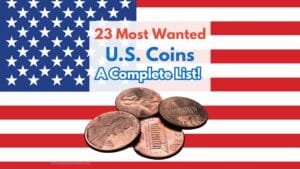Struck during heightened demand due to a national coin shortage, the 1968 Lincoln Penny often gets overlooked due to its common design and huge availability. But many collectors don’t know this ordinary coin has been in high demand due to its rare features and the potential for high-value!
So, if you have an old 1968 Lincoln Memorial Cent, this guide is just for you! It will tell you about all the valuable factors, like mint marks, coin grades, and rare errors, that can transform this small cent into a coveted collectible coin!
1968 Lincoln Penny History & Background
With its high mintage of over 4.8 billion, the 1968 Lincoln Penny is a major part of the Modern Lincoln Cent series that replaced the traditional Wheat Cent in 1958. It was minted during a time of high demand for coins due to a shortage in the late 1960s.
The 1968 penny retained its bronze composition and was produced in large numbers at all three mint locations. While most 1968 pennies are common, rare examples are quite in demand among coin collectors.
| 1968 Lincoln Wheat Cent | Key Features & Facts |
| Coin Composition | 95% Copper, 5% Tin and Zinc |
| Minting Location | Philadelphia, Denver, San Francisco |
| Minting Year | 1968 |
| Face Value | 1-cent (0.01$) |
| Weight | 3.11 grams |
| Diameter | 19.05 mm |
| Thickness | 1.52 mm |
| Designer | Victor David Brenner, Gilroy Roberts |
| Mint Marks | D – Denver Mint, S – San Francisco no mint mark – Philadelphia Mint |
| Total Mintage | 4,855,462,077 |
Identifying the 1968 Lincoln Cent Design & Composition
The 1946 Lincoln Penny features the new Gilroy Roberts’ reverse design, which sets it apart from the initial pennies. Let’s understand all the design features of a 1968 penny:
1968 Lincoln Penny Obverse:

- A portrait of Abraham Lincoln, the 16th President of the States
- The minting year “1968” on the lower right
- The word ‘LIBERTY’ on the left side, in compact kerning
- The phrase “IN GOD WE TRUST” on the top along the edge
- The mint mark, if present, below the mint date
1968 Lincoln Penny Reverse:

- “UNITED STATES OF AMERICA” on the top along the edge
- The picture of the Lincoln Memorial (Washington, DC) with 12 columns, steps, and plinth
- The US motto, “E PLURIBUS UNUM,” above the hall
- The denomination, “ONE CENT,” along the bottom rim in bold font
Coin Composition & Dimensions
The 1968 Lincoln cent is made up of the Bronze alloy, which is 95% copper and 5% tin or zinc. The composition is responsible for the coin’s red finish and its weight of 3.11 grams.
As for its size, the 1968 Lincoln Memorial Cent has a diameter of 19.05 millimeters (0.75 inches), a thickness of 1.52 millimeters (0.06 inches), and features a plain edge. These dimensions have been consistent for one-cent coins for much of American history, excluding the war cents, which weigh less.
How to Assess a 1968 Lincoln Cent’s Value (5 Key Factors)
On average, a circulated 1968 Lincoln Memorial penny is worth only its face value of one cent, but uncirculated pennies and those with rare characteristics can fetch up to $5,000 or more!
Let’s understand what factors and rare features impact a 1968 Lincoln Penny coin value!
1. Coin Grading & Condition of 1968 Penny
The condition of a 1968 penny, graded professionally on a scale from Poor (P-1) to Perfect Mint State (MS-70), majorly affects its worth. Pennies graded MS-67+ or higher can sell for $2,000 or more, while those graded MS65 or less are worth less than $20.
These grades are assigned to a coin when they are graded by services such as PCGS, NGC, and ANACS. But you can also assess your 1968 cent’s condition by observing the sharpness of details in the following areas:
- Lincoln’s cheek and jaw area
- Hair details
- Lettering on both sides
- Steps detailed on the stairs of the Memorial
- The presence or absence of contact marks
2. Coin Toning & Discoloration
Due to its core copper content, a 1968 penny is prone to oxidation and toning, changing its color from red to brown. This discoloration can directly impact its worth.
1968 Copper cents, like other pennies, are divided into three color designations:
- Red (RD): The RD-graded 1968 pennies retain 95% or more of their original mint luster, looking the brightest red. Red pennies are the most valuable ones, fetching up to $500 – $1,000 in gem mint state (MS67+ or above).
- Red-Brown (RB): These coins feature red and brown patches due to 5-95% discoloration. More common than the RD 1968 Lincoln Cents, these coins are worth $10 – $25 in uncirculated condition.
- Brown (BN): These pennies, as the name suggests, retain less than 5% of their original red color and are mostly brown. Generally, BN-graded 1968 cents are the least valuable, but some collectors can buy the exceptionally brown coins for a decent amount!
3. Mint Marks & Mintage
Generally, the higher the mintage, the more common and less valuable the coin! So, the mintage and mint mark on your 1968 Lincoln Penny can also impact its value.
Now, the total mintage of the 1968 penny across all three mints is 4,855,462,077, which makes it quite common that cents from certain mint locations can be valuable. You can track the mint location by the mint mark on the coin’s obverse.
- 1968 No Mint Mark Penny: The Philadelphia Mint produced a total of 1,707,880,970 Lincoln pennies with no mint mark in 1968. These coins are quite common and are worth face value in circulated condition. Uncirculated 1968 no-mint mark pennies are worth $0.30-$5, with Gem Mint examples (MS-66 or above) fetching $100 or more.
- 1968 D Penny: With the highest mintage, the Denver Mint produced 2,886,269,600 Memorial cents with the “D” mint mark. More common than the Philadelphia pennies, the average value of a 1968 D Lincoln Cent in high-grade mint state ranges from $100 – $300.
- 1968 S Penny: The San Francisco Mint produced only 258,270,001 pennies in 1968. These coins bear an “S” mint mark and are more valuable than the rest. An MS-67+ 1968-S penny sold for almost $4,000 on Heritage Auctions. Lower-grade mint pennies are worth $5 to $10.
You can refer to this detailed 1968 Lincoln Penny value chart to assess your coin’s worth based on condition and mint marks.
| Coin Grades | 1968 1C No Mint Mark Value | 1968 D Penny Value | 1968 S Penny Value |
| Poor (0) to Extremely Fine (XF45) | Face Value | Face Value | A few cents above face value |
| Almost Uncirculated (AU50) to Mint State (MS60) | 30 to 50 cents | 20 to 40 cents | 50 to 70 cents |
| Mint State (MS61 – MS64) | $1 – $10 | $1 – $5 | $1 – $5 |
| Mint State (MS65 – MS66+) | $10 – $60 | $5 – $50 | $5 – $60 |
| Mint State (MS67 – MS67+) | $150 – $2,000 (MS-67+) | $100 – $350 | $100 – $4,000 |
| Mint State (MS68 or Above) | N/A | N/A | N/A |
4. 1968 Lincoln Penny Proof Coins
Apart from regular 1968 pennies, the San Francisco Mint produced 3,041,506 proof 1968 Lincoln pennies. These coins feature sharper details, a mirror-like surface, and an “S” mint mark.
Depending on the sharpness of the proof finish, 1968 proof coins are divided into three categories:
- Regular Proofs: These are regular proof coins with a uniform, mirrored surface. Most uncirculated proof coins have values ranging from $1 to $10, with the highest-grade (PR-69) example fetching $100 – $150.
- Cameo Proofs (CAM): These proof coins feature frosted devices (raised areas) contrasting with mirrored fields. They’re more valuable than regular proofs, typically worth $10 to $50.

- Deep Cameo (or Ultra Cameo) Proofs: These proof coins have the most pronounced contrast between frosted devices and mirrored fields. Rarest and most valuable, 1968-S DCAM proofs often fetch $50 to $200 or more.
5. 1968 Lincoln Penny Mint Errors List
Rare mint errors and varieties can significantly increase your 1968 Lincoln Memorial Cent value. Here are the most valuable errors to look for:
Doubled Die Obverse
The most common mint error found on a 1968 Lincoln Penny is the Doubled Die Obverse (DDO) error, which causes a doubling in the lettering of “LIBERTY” and the date “1968”. While this error is usually found on regular strikes, for 1968 pennies, it’s mostly seen on proof coins.

A 1968-S Lincoln Penny with DDO can be worth $20-$100 with minor doubling and average condition and up to $1,000 for Gem Mint condition, like this PR68 1968-S 1C example that sold for $517 on Heritage Auctions.
Off-center Strikes
This error occurs when the coin planchet gets misaligned inside the die. If the design is too off-center, part of it gets left out. The value of an off-center 1968 Lincoln Penny depends on the degree of misalignment.
Minor off-center strikes (5-10%) can add $5-$20 to the 1968 penny’s average value, while more dramatic examples can be worth $50 or more. For example, an MS65BN-graded 1968-D Lincoln penny with a 60% off-center strike sold for $86 on Heritage Auctions.
Repunched Mint Mark
This error happens when the mint mark “S” or “D” gets punched more than once, slightly offset. Sometimes the marks are punched so off-set that you can easily see them overlapping.
Depending on the mint mark’s visibility, this error can add $5-$25 to the 1968 Lincoln Penny coin value.
Bonded With a Costa Rica 5 Centimos Blank
This is a rare 1968 penny error coin that happened to get struck on a Costa Rica 5 Centimos Black, resulting in a two-tone (red and silvery) surface bonded together. Only one such error coin has been graded by PCGS and sold for a mind-boggling price of $15,000 on Heritage Auction!
Struck on a Canada Dime Planchet
When a 1968 Lincoln Penny design is mistakenly struck on a Canada Dime black, the result is a rare coin with a faded Lincoln Memorial Cent design on silver. One such error coin, graded MS64 by NGC, sold for $1,410 on Heritage Auctions.
4 Steps to Identify a Fake 1968 Lincoln Cent
If you’re struggling to find out whether your 1968 penny is real or not, follow these simple steps:
- Verify the Composition: An authentic 1968 penny should not be attracted to a magnet due to its copper content. Magnetic attraction suggests a counterfeit.
- Check the Weight and Dimensions: Use a precise scale and calipers to ensure your 1968 Lincoln Cent matches the official weight and dimensions of this coin.
- Examine the Mint Mark: Ensure the size, position, and style of the “S” and “D” mint marks are correct. Fake coins may have forged mint marks.
- Check the Date Font: The date “1968” should match the style, size, and font used in 1968 for all Lincoln Pennies. Fakes often use incorrect fonts or positioning.
If still in doubt, seek the opinion of a professional numismatist or coin grading service.
In conclusion, a 1968 Lincoln Cent might initially appear like a common, worthless coin. But with rare features and errors, this ordinary coin can actually be worth a lot. Some other common-looking Lincoln pennies that are valuable are the 1946 penny, the 1969 penny, and the 1942 penny. Find the true value of these American pennies with my guides!
Note: This article is intended for informational, educational, and entertainment purposes only. Some images are illustrative and may not represent actual brands, products, or related entities. All trademarks, product names, brand logos, packaging, and other intellectual property referenced remain the exclusive property of their respective owners. Any brand mentions or references are provided solely for descriptive and educational context and do not imply any formal or commercial association.









